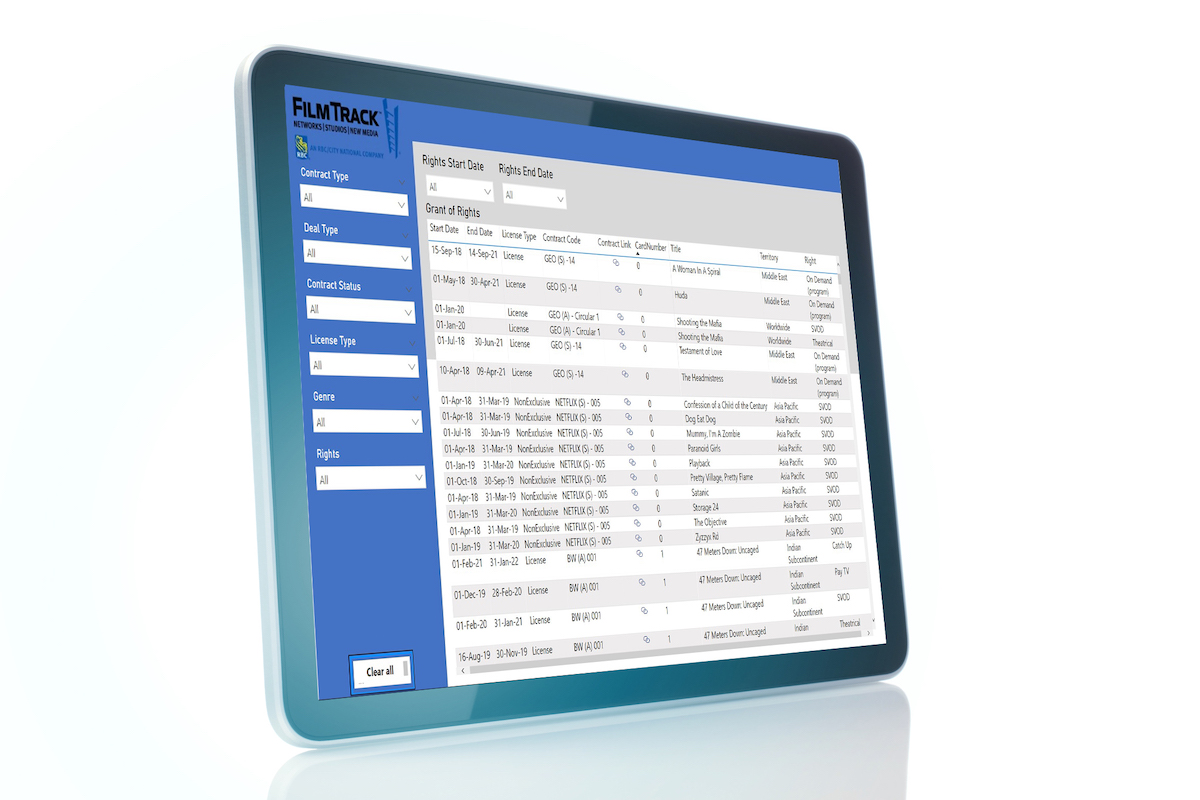Discover Royalty Management: Understanding Royalty Rates, Payments, and Licensing
Before we hit play on Royalty Management, let’s pause for some quick back story.
It’s no secret that the media & entertainment industry is becoming increasingly fragmented… but why? Well, we all know that no two consumers are exactly alike, but today there’s one thing that nearly all of us have in common: the expectation of flexibility. And with that expectation comes the need for more and new ways to cater to and ultimately satisfy us, the modern media consumer.
Let’s rewind just a little.
I’m sure we all remember a time in the not-so-distant past when we would flock to movie theaters to see the newest feature flicks and gather around the television when our favorite shows aired. We were at the mercy of theatrical release and broadcast television schedules, forcing us to adjust our lives to enjoy the movies and shows we loved.
Ok, let’s fast forward back to now.
As consumers today, we don’t want our entertainment dictating our schedules. We want it to fit into our lives seamlessly and effortlessly. We want to binge the entire series of Breaking Bad in a weekend, or stream live NFL games on-the-go from our smartphone or tablet. With the exception of blockbuster hits like Avengers or Star Wars, which still have the power to lure some of us to the theater, most of us prefer to to stay in the comfort of our own homes and watch what we want when we want. This new trend has completely turned the traditional theatrical distribution model on its head and left the entertainment industry scrambling to pivot. Enter the new frontier of streaming and on-demand video and the complex royalty and licensing contracts that come with them (more on those in just a minute).
So what are we talking about when we say “streaming” and “on-demand” video?
Streaming video and video on-demand (or VOD for short) require an internet connection and a device to access the content. This could be anything from your smartphone, tablet, or computer to a smart TV, Roku, AppleTV, or Chromecast. And while “streaming” generally implies live content such as a sporting event or webinar, video on-demand is pre-recorded content that can be viewed anytime anywhere. It comes in three basic flavors:
SVOD (subscription video on-demand): These services allow users to consume premium content when they want and where they want in exchange for a recurring monthly fee (Netflix, Hulu, Disney+, AppleTV+, HBO Now).
TVOD (transactional video on-demand): With these services, users can choose to pay a one-time fee to rent or purchase the content (iTunes, Google Play).
AVOD (advertising video on-demand): These services allow users to watch ad-supported content for free (YouTube, Tubi, Crackle).

Let’s unpause now and rejoin our originally scheduled topic: Royalty Management.
Now that we know the back story and understand how the entertainment industry has changed, it’s time to talk about royalty management, licensing, and the impact that the shift to video on-demand has had on both.
Royalty Management: Demystifying Royalties
Before we can talk about managing them, we need to understand what royalties are, right? So, let’s ask the question…
What is a Royalty?
Royalties are payments for the sales or use of intellectual property such as movies, TV shows, or music. They are typically a percentage of the gross or net revenues and are paid according to contractual agreements for that specific piece of intellectual property. So if you’re an actor, director, producer, artist, performer, studio, or any other party that is contractually owed royalties on a given piece of intellectual property, the payments you receive would be considered Royalties In. The party or entity collecting revenues and paying the royalties would refer to them as Royalties Out.
Royalty Rates and Payments: How They Work
If you’re wondering what a customary royalty rate might be, the answer isn’t quite as simple as you might think. Royalty rates vary depending on industry, and even within an industry are completely unique to each individual contract agreement. So one could say that on average, between movies, tv shows, music, books, images, logos, technology, and any other kind intellectual property you can imagine, royalty rates tend to be anywhere between 1% and 20%. But in reality, they can be whatever the parties involved agree on. Therefore, royalty payments will be a function of how much revenue is made on a piece of intellectual property and what percentage of that is owed to you.
Licensing: Key Element of Royalty Management
Ok, now that we understand what royalties are, let’s talk about the second part of the equation: Licensing.
If you are the owner of a piece of intellectual property and someone wants to use your intellectual property to make money, they will agree to pay you a fee in exchange for the right to use or “license” it for a certain period of time. In this situation, you would be considered the Licensor and they would be considered the Licensee.
So let’s say you own the rights to Movie X and Netflix wants Movie X to be available for their subscribers to watch on-demand. The licensing agreement between you and Netflix will stipulate the date window that Movie X will be available on their platform and whether it will be exclusively available on their platform or if you are also allowed to license it to other on-demand services during that date window. This is why you may notice some of your favorite movies or tv shows mysteriously disappear from on-demand services you subscribe to, or why only certain seasons of tv shows are available while others are not.
Let’s say in addition to Movie X, you also own the rights to all 6 seasons of TV Show Y. If Netflix wants to license your tv show as well, but you already have an exclusive licensing deal with Hulu for seasons 1-3, then you are only able to license seasons 4-6 to Netflix. However, once your licensing deal with Hulu expires you may now decide to license those first 3 seasons to Netflix. And although there are more variables at play than just date window and exclusivity, that’s how licensing works in a nutshell.
Brand Licensing: Expanding Your Intellectual Property Portfolio
Movies, tv shows, and technology are not the only intellectual properties that get licensed. Many brands license their logos, images, characters, or mascots to third parties for a variety of different products from t-shirts and hats to mugs and backpacks. The brand can stipulate in their licensing deal what images or logos are allowed to be used, how they are allowed to be used, and in what regions and for how long they are allowed to be used.

Contract Terms: this is where things get complicated
Ok, get your popcorn ready because this is where the plot thickens.
Let’s say you’re an actor who starred in Movie X which releases this summer to movie theaters. Your contract says you are owed a 2% royalty on gross box office revenue in North America, 1% in Europe and Australia, and .5% in the rest of the world. Not too complicated, right? And let’s say after the theater run is over, you get 1.5% of net revenue from DVD/Blue-ray sales worldwide and .5% of gross revenue whenever Movie X airs on cable or network television indefinitely into the future (this is referred to in contract language as “in perpetuity”). Ok, it’s getting a little bit trickier, but still not too crazy. Well here comes a little plot twist… video on-demand.
Video On-Demand Licensing Agreements
Unlike traditional contracts that are pretty straightforward, VOD licensing agreements can be structured in a variety of ways. Sometimes there’s a fixed fee per movie title or tv series. Sometimes there’s a fixed fee for a bundle of movie titles and tv shows. Sometimes there’s a variable fee that is determined by advertising dollars or subscription fees. And sometimes there’s a combination of fixed fees and variable fees in a VOD contract. As we’re about to see, VOD has taken contracts that used to be like 2-dimensional checkerboards and turned them into 3-dimensional Rubik’s cubes that can be twisted, turned, and mixed up into mind boggling configurations.
To get an idea of how, let’s get back in character for a moment. As an actor in Movie X, you’re entitled to the royalties we mentioned above, but now we need to address video on-demand. Let’s say your contract says that you get .5% of gross TVOD purchases in North America and Europe and .2% from TVOD rentals in North America and Europe. And let’s say that both of those percentages will go up by .2% every year for the next 15 years at which point they will remain fixed in perpetuity after that. You remember that I said North America and Europe, right? Good, because all of those numbers change for Asia and Australia, and then change again for the rest of the world.
But wait, there’s more. You also get .3% of VOD revenue acquired when Movie X is licensed to streaming services in North America and Europe, .2% in Asia and Australia, and .15% in the rest of the world (except for Spain and Italy where you don’t get anything for some reason that I’m sure is explained in your contract). But that percentage expires after 10 years in North America and Europe, 12 years in Asia and Australia, and 13 years in the rest of the world. Oh, and I forgot to mention that that percentage also decreases by .02% every 3 years until expiration. And if Movie X is licensed to a VOD service as part of a bundle with other movies and tv shows, your percentage needs to be calculated based on the licensing fee divided by the number of other movies and tv shows in the bundle (some of which could be worth more than others). Oh, and let’s not forget all of the different currencies that are being collected around the world and how those translate into U.S. dollars, because as an America actor, you do want to be paid in U.S. dollars, right?
Does your brain need to be rebooted yet?
Just imagine the fact that our Movie X example is completely made up and that many contracts in the entertainment industry get much more complex than this. Take for example a tv series where all of those royalties are not only different per season, but completely different per individual episode. The Rubik’s cube is quickly beginning to feel like an unsolvable mess of jumbled colors.

Royalty Management Software
So who is calculating all of these numbers and making sure everyone is getting paid what they are owed for all of the millions of pieces of intellectual property out there? In simpler times, spreadsheets and some basic legacy software could do the trick, but with the complexity of today’s entertainment landscape, those methods just can’t come close to cutting it anymore. There simply aren’t enough possible man hours to manually manage the complex financials as digital channels continue to become the primary means of distribution. Businesses in the entertainment and media industries are adopting newer, more powerful, and more flexible royalty management software solutions that can automate royalty calculations in a matter of seconds.
Royalty Management Made Simple
A cloud-based solution like FilmTrack makes the overwhelming task or royalty management much easier. Not only does it handle the seemingly infinite complexity of modern contracts with ease, but it brings every phase of the intellectual property lifecycle under one roof with real-time data insights and analytics reports.
But most importantly, FilmTrack is designed with flexibility in mind. And let's not understate how huge this point is to the outcome of our story. Remember at the beginning when we said that the expectation of flexibility was the one thing that nearly all modern consumer's had in common? Well, that was a little bit of foreshadowing, because that is also the expectation that nearly all modern entertainment media companies have in common.
Not only does a rights management platform need to be prepared to handle the challenges of today’s royalty and licensing contracts, but it needs to be able to adapt to wherever the entertainment industry goes next. And as the last few years have shown us, we’re very likely in for some plot twists and surprise endings.
Roll The Credits
So as we’ve seen, the introduction of new technology and the expectation of flexibility from today’s media consumer have turned the industry on it’s head and paved the way for streaming video and video on-demand. And with that shift has come a level of complexity we’ve never seen in royalty management and licensing. But thanks to modern royalty management software like FilmTrack, companies are able to handle this new complexity with ease and confidence, knowing that whatever comes next, they’ll be ready to adapt.
And with that, we conclude our journey through royalty and licensing management. But don’t put your popcorn away yet, because this may not be the end of the movie… it may just be the end of episode 1.
Contact us to request a demo and experience how FilmTrack has the simplest and most powerful end-to-end rights management solutions in the entertainment industry.



